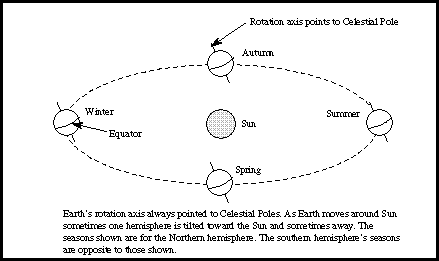
A winter storm system will rapidly intensify over the Midwest on Sunday and track through the Great Lakes on Monday. Periods of heavy snow are anticipated across the Upper Great Lakes late Sunday and continuing into Monday. At least 1/10 inch of ice accumulation is expected from a wintry mix across much of the interior Northeast U.S. starting Sunday afternoon. Read More >
Why do we have the seasons?![]()

As the earth spins on its axis, producing night and day, it also moves about the sun in an elliptical (elongated circle) orbit that requires about 365 1/4 days to complete. The earth's spin axis is tilted with respect to its orbital plane. This is what causes the seasons. When the Earth's axis points towards the Sun, it is summer for that hemisphere. When the Earth's axis points away, winter can be expected. Since the tilt of the axis is 23 1/2 degrees, the north pole never points directly at the Sun, but on the summer solstice it points as close as it can, and on the winter solstice as far as it can. Midway between these two times, in spring and autumn, the spin axis of the Earth points 90 degrees away from the Sun. This means that on this date, day and night have about the same length: 12 hours each, more or less.
Why should this tilt of the Earth's axis matter to our climate? To understand this, take a piece of paper and a flashlight. Shine the light from the flashlight straight onto the paper, so you see an illuminated circle. All the light from the flashlight is in that circle. Now slowly tilt the paper, so the circle elongates into an ellipse. All the light is still in that ellipse, but the ellipse is spread out over more paper. The density of light drops. In other words, the amount of light per square centimeter drops (the number of square centimeters increases, while the total amount of light stays the same).
The same is true on the Earth. When the Sun is overhead, the light is falling straight on you, and so more light (and more heat) hit each square centimeter of the ground. When the Sun is lower in the sky, the light gets more spread out over the surface of the Earth, and less heat (per square centimeter) can be absorbed. Since the Earth's axis is tilted, the Sun is higher when you are on the part of the Earth where the axis points towards the Sun, and lower on the part of the Earth where the axis points away from the Sun.
For the Northern Hemisphere, the axis points most toward the Sun in June (specifically around June 21), and away from the Sun around December 21. This corresponds to the Winter and Summer Solstice (solstice is Latin for "the sun stands"), or the midpoints of w inter and summer. For the Southern Hemisphere, this is reversed.
inter and summer. For the Southern Hemisphere, this is reversed.
For both hemispheres, the Earth is 90 degrees away from the sun around March 21 and then again around September 21. This corresponds to the Fall and Spring Equinox (equinox is Latin for "equal night"). Everyplace in the world has about 12 hours of daylight and 12 hours of night.
Day and night are not exactly of equal length at the time of the March and September equinoxes. The dates on which day and night are each 12 hours occur a few days before and after the equinoxes. The specific dates for this occurrence are different for different latitudes.
On the day of the equinox, the geometric center of the Sun's disk crosses the equator, and this point is above the horizon for 12 hours everywhere on the Earth. However, the Sun is not simply a geometric point. Sunrise is defined as the instant when the leading edge of the Sun's disk becomes visible on the horizon, whereas sunset is the instant when the trailing edge of the disk disappears below the horizon. At these times, the center of the disk is already below the horizon. Furthermore, atmospheric refraction (or bending) of the Sun's rays cause the Sun's disk to appear higher in the sky than it would if the Earth had no atmosphere. Thus, in the morning, the upper edge of the disk is visible for several minutes before the geometric edge of the disk reachs the horizon. Similarly, in the evening, the upper edge of the disk disappears several minutes after the geometric disk has passed below the horizon.
For observers within a couple of degrees of the equator, the period from sunrise to sunset is always several minutes longer than the night. At higher latitudes in the Northern Hemisphere, the date of equal day and night occurs before the March equinox. Daytime continues to be longer than nighttime until after the September equinox. In the Southern Hemisphere, the dates of equal day and night occur before the September equinox and after the March equinox.